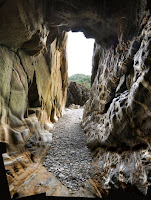 I have four new works in the current North Devon Arts, New Year New Work show at Broomhill Art Hotel and five more in a two day group show at Holsworthy Memorial Hall over the weekend of 21st & 22nd Feb for the inaugural Ruby Country Art Expo.
I have four new works in the current North Devon Arts, New Year New Work show at Broomhill Art Hotel and five more in a two day group show at Holsworthy Memorial Hall over the weekend of 21st & 22nd Feb for the inaugural Ruby Country Art Expo.
Both of these shows demanded new work, the NDA?s had to have been made during the last year and the Expo?s the last two years. It?s always good to make new work and it gives me the impetus to look at all of my ?work-in-progress? and decide which ones I?m still drawn to and will look good, once completed, in the respective shows.
One of the images I chose to bring on from thumbnail to artwork was Hermit Hole, Grand Canyon, March 2008 (thumbnail on the left/above). This was originated from time based in Tucson in the winter of early 2008. This was the first trip I had hiked below the rim of the Grand Canyon and it was fantastic. A lot of compacted snow and ice at the trail heads but further down it got brighter and warmer. This image, made of 47 separate digital frames, was found on the Hermit Trail, hence its name. It was the edge of what would have been a huge waterfall after a good thunderstorm, but when I was there it was totally dry, but there were the odd pools of water left further down.
 Here you see how the image has radically changed through the intentional reconstruction of the many photographic frames to make it as realistic and truthful as possible but without loosing its sense of mystery and place. There is a continual battle as I construct an image between the placing of each ?jigsaw puzzle piece? on my computer screen in Photoshop, making sure each piece is in the right place and at the right angle; with my memory of how the place looked and felt, bearing in mind that I am transforming a three dimensional space, a 180 degree, fish-eye view, of a place onto a two dimensional canvas.
Here you see how the image has radically changed through the intentional reconstruction of the many photographic frames to make it as realistic and truthful as possible but without loosing its sense of mystery and place. There is a continual battle as I construct an image between the placing of each ?jigsaw puzzle piece? on my computer screen in Photoshop, making sure each piece is in the right place and at the right angle; with my memory of how the place looked and felt, bearing in mind that I am transforming a three dimensional space, a 180 degree, fish-eye view, of a place onto a two dimensional canvas.
 A similar, but not so dramatic difference was noticed with an image for the Ruby show: Striped Wall, Combe Martin. I have taken to making a thumbnail of an image using Photoshop?s ?photomerge? to give me an idea if it ?works? or whether I want to pursue it any further. Photomerge is great for merging up to 5 or 6 frames together (so long as they have been taken on a similar plain and have similar tonal values); but to combine more than this successfully I have to make my frames thumbnail sized.
A similar, but not so dramatic difference was noticed with an image for the Ruby show: Striped Wall, Combe Martin. I have taken to making a thumbnail of an image using Photoshop?s ?photomerge? to give me an idea if it ?works? or whether I want to pursue it any further. Photomerge is great for merging up to 5 or 6 frames together (so long as they have been taken on a similar plain and have similar tonal values); but to combine more than this successfully I have to make my frames thumbnail sized.
 Another use for this thumbnail is as an image to send to a gallery etc for inclusion in a show or for a press release. Once the image has been accepted I have to put the real work in making the constructed image full size, in this case a file of 750mb to make a fine quality print of up to 1.5metres.
Another use for this thumbnail is as an image to send to a gallery etc for inclusion in a show or for a press release. Once the image has been accepted I have to put the real work in making the constructed image full size, in this case a file of 750mb to make a fine quality print of up to 1.5metres.